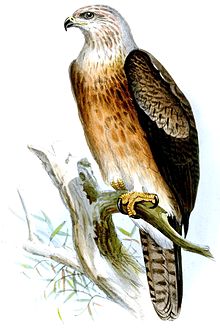This article includes a list of general references, but it lacks sufficient corresponding inline citations. (July 2007) |
Gurney's eagle (Aquila gurneyi) is a large eagle in the family Accipitridae. It is found in New Guinea and Wallacea, and is an occasional vagrant to Australia.
| Gurney's eagle | |
|---|---|

| |
| Scientific classification | |
| Domain: | Eukaryota |
| Kingdom: | Animalia |
| Phylum: | Chordata |
| Class: | Aves |
| Order: | Accipitriformes |
| Family: | Accipitridae |
| Genus: | Aquila |
| Species: | A. gurneyi
|
| Binomial name | |
| Aquila gurneyi Gray, GR, 1861
| |
The common name and Latin binomial commemorate the British banker and amateur ornithologist John Henry Gurney (1819–1890).[2]
Description edit
This eagle is a fairly large species, though mid-sized as a member of the genus Aquila. It is mainly dark brown to black, with paler undersides to its flight feathers and a rounded tail. Its body length is 74–86 cm (29–34 in) with a wingspan of between 1.65 and 1.9 m (5 ft 5 in and 6 ft 3 in). Females are larger than males. One immature female weighed 3.06 kg (6.7 lb).[3][4] Males are estimated to weigh about 2.21 kg (4.9 lb) in this species.[5] Its wings are held level when gliding. It feeds on mammals (such as cuscuses), reptiles, fish, and birds.
Juveniles have brown scapular feathers, wing coverts, and back, mottled with gray and buff. The black tail is faintly barred, and the head and underparts are light brown fading into a cream-colored belly and legs.
Range and habitat edit
Gurney's eagle is found from the Moluccas to Irian Jaya and most of New Guinea, from sea level to 1500 meters above sea level. It has been recorded from Saibai and Boigu islands in north-western Torres Strait, thus putting it on the Australian bird list. it inhabits a wide range of habitats from sea level to the snow line.
Conservation edit
Gurney's eagle occurs at low population densities and is likely to be declining slowly through habitat loss and degradation. It is considered to be Near Threatened and is listed on CITES Appendix II.
References edit
- ^ BirdLife International (2016). "Aquila gurneyi". IUCN Red List of Threatened Species. 2016: e.T22696056A93541423. doi:10.2305/IUCN.UK.2016-3.RLTS.T22696056A93541423.en. Retrieved 12 November 2021.
- ^ Beolens, Bo; Watkins, Michael (2003). Whose Bird? Men and Women Commemorated in the Common Names of Birds. London: Christopher Helm. p. 153.
- ^ "Raptors of the World" by Ferguson-Lees, Christie, Franklin, Mead & Burton. Houghton Mifflin (2001), ISBN 0-618-12762-3
- ^ Dunning, John B. Jr., ed. (2008). CRC Handbook of Avian Body Masses (2nd ed.). CRC Press. ISBN 978-1-4200-6444-5.
- ^ Parry, S. J. (2001). The booted eagles (Aves: Accipitridae): perspectives in evolutionary biology. University of London, University College London (United Kingdom).
Works cited edit
- BirdLife International (2006). Species factsheet: Aquila gurneyi. Downloaded from http://www.birdlife.org on 9/12/2006
- Coates, B.J. (1985). The Birds of Papua New Guinea, Vol. 1, Non-Passerines. Dove: Alderley, Queensland. ISBN 0-9590257-0-7
- Morcombe, Michael (2000). Field Guide to Australian Birds. Steve Parish Publishing: Queensland. ISBN 1-876282-10-X
